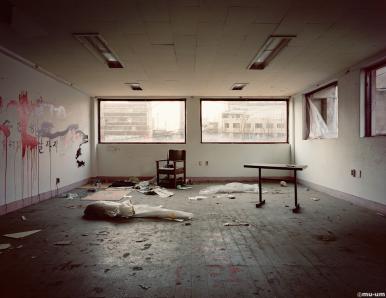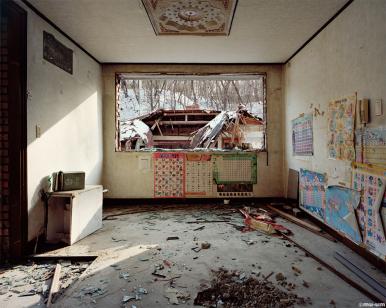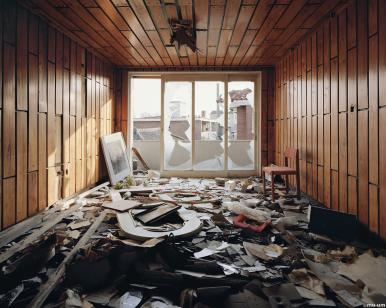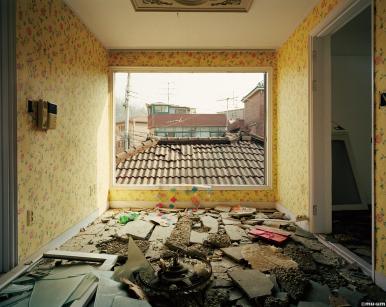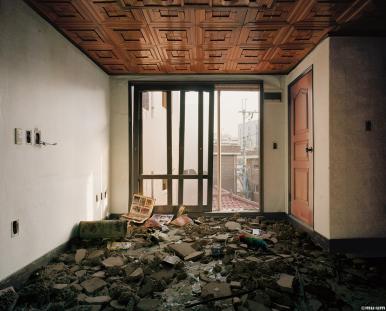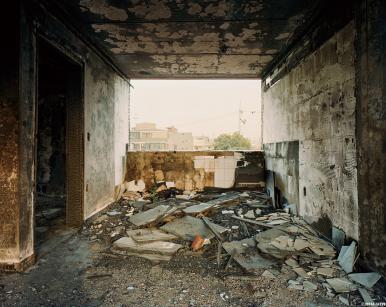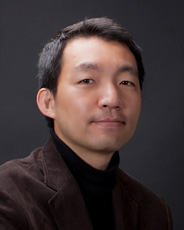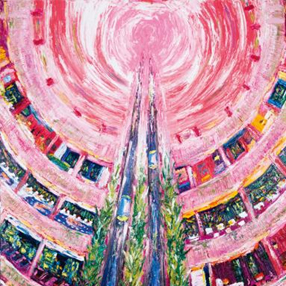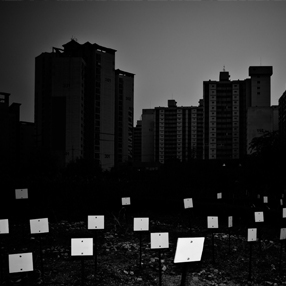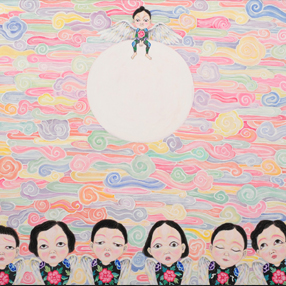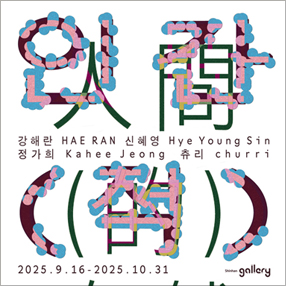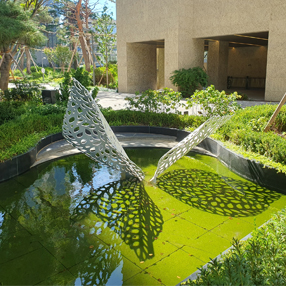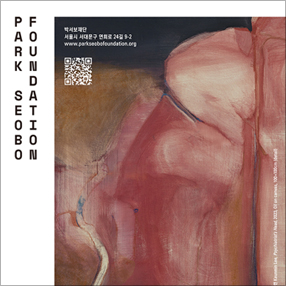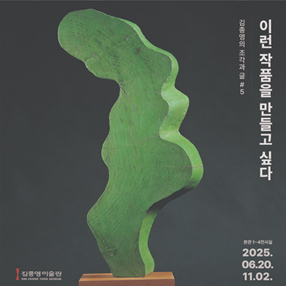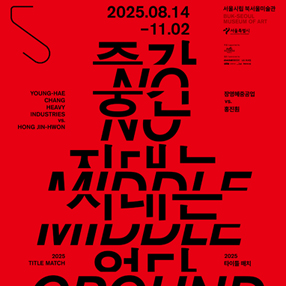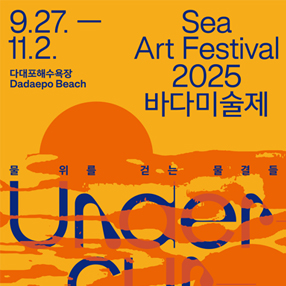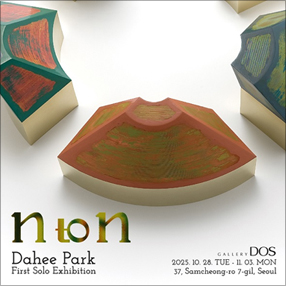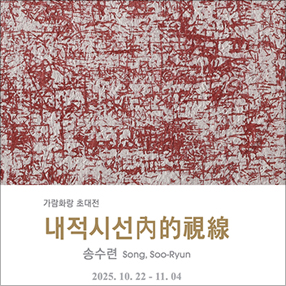본문
-
최우영
아이파크몰이 보이는 방, 한강로3가 Digital Print, 90x110cm, 2009, 개인소장
-
최우영
유리의 얼굴이 그려진 방, 이문동 Digital Print, 90x110cm, 2009, 개인소장
-
최우영
작은의자가 놓여진 거실, 아현동 Digital Print, 90x110cm, 2009, 개인소장
-
최우영
노란벽지로 도배된 방, 남가좌동 Digital Print, 90x110cm, 2009, 개인소장
-
최우영
외국인 노동자 부부가 살던 방, 상왕십리동 Digital Print, 90x110cm, 2009, 개인소장
-
최우영
작은 잡초가 자라고 있는 방, 성수동1가 Digital Print, 90x110cm, 2009, 개인소장
-
Press Release
망각과 맞서는 부재의 기호들
'잊혀진 이웃' 연작에서 최우영은 서울 도심의 재개발지역에 대한 시각적 탐사를 해나가고 있다. 재개발을 둘러싼 각종 사회문제가 제기되어온 것은 어제 오늘의 일이 아니며, 나아가 여전히 현재진행형으로 최근의 용산 참사에까지 이르고 있다. 도심 지역의 재개발 사업이 단순히 도시미관을 해치는 낡은 시설물들을 해체하여 현재의 도시경관과 조화를 이루도록 개축하는 데 있지만은 않다는 점은 분명하다. 도시란 수축과 팽창을 거듭하면서 꾸준히 변모해나가는 살아 있는 공간이며, 삶의 양태변화에 부합하는 장소로 거듭나야 하는 가변적인 공간이다. 재개발은 그 변화를 끌어내기 위한 최소한의 수단이다. 문제는 부작용을 줄일 수 있는 최선의 방법을 찾아내는 일이다. 개발이 새로운 삶의 환경을 인위적으로 만들어나가는 것이라면, 거기에는 필연적으로 단절이 개입하기 때문이다. 삶을 이전과 이후, 둘로 나누어버리는 단절 앞에서 사람은 어찌할 바를 모른다. 주어진 환경에 적응하여 살다가 갑작스럽게 낯선 환경에 팽개쳐지는 것이다. 더욱이 재개발이 만들어내는 단절의 현실은 한국사회의 특수성과 맞물려 단지 낯선 환경을 만들어내는 데 그치지 않고, 그곳에서 살아가던 사람들을 쫓아내는 결과를 빚어낸다. 작가는 그렇게 쫓겨난 사람들이 살았던 공간의 폐허를 일관된 시각 하에서 담아내고 있다.
'잊혀진 이웃'의 일차적 의미가 도시 기록에 있는 것은 맞지만 그것이 딱딱하고 무미건조한 '자료' 생산을 위한 기록에서 멈추는 것은 아니다. 작가가 이 작업에서 시도하고 있는 '기록'의 방법론은 정보를 긁어모아 재개발이 야기한 부정성을 알리는 계몽과 설득의 그것만이 아니기 때문이다. 오히려 작가는 사회학적 관심에서 출발하여 이 빈 집들에서 풍겨 나오는 정취를 쓸쓸한 서정주의의 차원으로 끌어올리고 있다. 사람들이 쫓겨난 빈 집에서 서정성을 보는 것은 어떤 점에서 이율배반적일 뿐만 아니라 퇴폐적이기까지 하다. 거기에는 무엇보다도 우선 박탈당한 삶이 은폐되어 있기 때문이다. 재개발이 표방하는 고상한 명분과 소수의 사람들에게만 주어지는 경제적 혜택의 뒤편에는 훨씬 많은 실거주자들의 신음과 추방의 그림자가 드리워져 있는 것이다. 이를 눈치 챌 수 있도록 돕는 잔잔한 형식과 상징의 결이 이 작업의 쓸쓸한 서정주의를 만들어내는 힘이라 할 수 있겠다. 그것이 이 작업을 정교한 메시지의 전달을 위해 강론에 가까워 지는 설득적 이미지와 구분해준다.
우선 눈에 띄는 것은 빈 집들의 전면을 차지하고 있는 창문이다. 작가는 재개발의 전모를 보여주는 잡다한 주변 정황들을 과감히 배제하고 빈 집의 내부, 그것도 거실과 같은 실내 공간을 선택하여 이를 재개발의 정형으로 제시한다. 헐려나간 건물의 일부나 길 주변에 흩어져 있을 법한 돌무더기, 무너진 벽과 같은 재개발의 보편적인 상징들은 보이지 않는다. 대신 실내에 어지럽게 널려 있는 생활소품들과 뜯겨나간 벽지, 무너져 내린 천정, 헐린 벽의 파편 등이 그것을 대신하고 있다. 이 실내공간의 전면에 위치한 창문도 온전하진 않다. 창틀은 심하게 훼손되어 건물 구조로서의 뚫린 벽에 불과한 모습인 것이다. 바깥 공기를 막아주던 유리도 깨져나가 볼품없는 창은 단지 바깥 세계를 향해 열려 있을 뿐이다. 창을 통해 보이는 세계, 그것은 폐허로 변해버린 빈집과 확연히 구분되는 현실공간이다. 지금은 초라하게 무너져 내렸지만 한때는 이곳도 창 너머로 보이는 세계와 크게 다르지 않았다. 아직 채 뜯겨나가지 않은 반투명의 커튼 뒤로 보이는 시가 풍경, 흉측한 몰골만 남은 사각의 틀 너머로 펼쳐진 야산, 외관은 아직 멀쩡해 보이는 이웃 동네의 주택 단지, 그 너머에 우뚝 솟아있는 아파트, 이 모든 것은 잔해만 남은 실내와 확연히 비견되는 모습이다. 요컨대 폐가가 되어버린 이 빈집들도 예전에는 저 온전한 세계에 속해 있었다. 그러나 이제는 창밖으로 보이는 저 세계로 다시 돌아갈 수 없다. 무너져 내린 천정이나 뜯겨나간 벽들과 함께 이 빈집들은 구겨진 세계가 되어버렸다. 한편 완전히 뜯겨나가 사각의 틀만 남아 있는 창은 액자처럼 보이기도 한다. 그 창이 보여주는 바깥 풍경은 캔버스 위에 그려진 그림과도 같다. 잘게 조각난 벽의 파편들이 어지럽게 널려 있는 어수선한 실내에 비해 단정하게 정돈된 창밖의 모습은 상대적으로 얼마나 정갈해 보이는가. 정면에 위치한 창틀이 보여주는 바깥 세계는 한때 이곳에 살았던 쫓겨난 이들의 눈에는 가닿고 싶은 바람으로서의 세계, 요컨대 동경의 대상처럼 보인다. 이 칙칙한 빈집이 암울한 현실이라면 창틀이 보여주는 모습은 집 잃은 자들이 속하지 못한 저 너머의 세계인 셈이다. 그렇게 창틀은 어디론가 떠나버린 이 빈집의 옛 주인들의 암담한 심경에 대한 메타포가 된다.
다음은 바닥에 나뒹굴고 있는 집의 상처와 이주의 흔적들. 빈집들이 철거될 운명에 처해 있음을 알려주는 징표들은 무수히 많다. 천정의 조명등이 뜯겨나간 자국이나 누더기가 되어버린 벽지, 해체된 각종 건축자재들을 한 곳에 쌓아놓은 모습, 배선이 훤히 보일 정도로 무너져 내린 천정, 바닥에 내팽개쳐진 창문, 밟으면 버석거릴 듯이 널려 있는 깨진 유리조각, 이 모든 집의 파편들은 이제 이 빈집의 기능이 사라지고 없음을, 더 이상 집의 구실을 할 수 없음을 여실히 보여주고 있다. 조형적으로 보자면 주의를 분산시키는 잡다한 집의 파편들 때문에 구성이 어지러워질 수 있지만 중앙에 위치한 창문으로 수렴되는 원근법적 구도가 시선을 모아주고 바닥에 널린 잔해들이 덩어리로 뭉쳐 화면을 단순화시키는 효과를 낳는다. 복잡한 화면에 간결한 구조가 생겨나는 것이다. 또한 양 옆에 위치한 깔끔한 벽면에 비해 바닥에 널린 조각들의 무게감은 화면에 안정감을 실어주기도 한다. 이것이 자칫하면 어지럽고 불안정해질 수 있는 폐허의 공간에 안정된 조형성을 부여해준다.
작가는 황량한 빈집들의 모습에서 결국 망각의 문제를 환기시킨다. 주변에 살던 이웃들이 모두 어디론가 떠나버린 이곳, 남아 있는 것은 폐허뿐이지만 그마저도 조만간 사라질 운명이다. 빈집들은 주인에 대한 기억을 아직은 희미하게 보존하고 있다. 그들이 미처 추스르지 못하고 남겨놓은 일상용품이 아니더라도 벽 구석구석에 묻어 있는 삶의 채취들이 그것을 붙들어두고 있는 것이다. 하지만 재개발이 진행되는 과정에서 그마저도 새로 들어설 건물들과 함께 사라질 운명이다. 이웃사람들의 보금자리였던 집들이 철거됨과 동시에 사람 자체도 망각되어 가는 재개발의 현실, 그래서 작가는 작업노트에 "누구도 그들에게 관심을 기울이지 않는다"고 냉소적으로 적는다. 그 망각을 일깨워준 것은 빈집의 공허함이다. 있을 때는 모르다가 없으면 알게 되는 것이 존재감 아니던가. 하여 이 빈집들에서 작가가 받은 트라우마는 무너진 벽이나 떨어져 나간 창틀, 구겨진 벽지, 어지럽게 널려 있는 벽돌조각들에서 오는 것이 아니라 아무도 없음, 요컨대 공허에서 온다. 그 공허가 상처를 주는 까닭은 타인에 대한 망각을 물려줄 터이기 때문이다. 문제는 그래서 삶의 터전을 잃고 제 집에서마저 쫓겨나 고통 받는 타인이 많아지는 상황과 더불어 타인의 고통에 대해 점차 우리 스스로 둔감해져가는 현실이다. 그렇게 무디고 둔탁해져가는 이유는 망각 때문이다. 하여 망각을 걷어내기 위해 작가는 공허를 환기시킨다. 창문 너머에서 들어오는 빛이 빈집 구석구석까지 샅샅이 훑고 지나가지만 아무도 없다. 바깥세상의 빛이 탐지해내는 것은 그들이 남기고 간 흔적과 폐기의 징후로 방안 가득 쌓인 집의 부속품들뿐이다. 그렇게 없음을 환기시킨다고 해서 망각을 이겨낼 수 있을까. 작가는 그 점에 대해 명쾌한 답을 갖고 있지는 않은 듯하다. 다만 망각과 싸우기 위해 빈집 가득 공허를 채워 이를 보여 주려 할 뿐이다. 요컨대 방안 가득 널려 있는 폐허의 기호들은 공허를 환기시켜주기 위한 소품들이라 할 수 있다. 사라진 타인들을 기억에 붙잡아둘 수 있는 수단은 그것뿐이므로, 다시 말해 그들의 부재는 그들이 남겨놓은 흔적을 통해서만 알려질 수 있으므로. 이처럼 작가가 빈집에서 진정으로 목격한 것은 파손된 집의 잔해가 아니라 그들의 부재라 할 수 있다. 그렇게 작가는 부재를 환기시킴으로써 망각과 맞서고 있는 것이다.
■ 박평종
The Forgotten Neighbors
잊혀진 이웃 서울이라 불리우는 도시공간은 수많은 유, 무기체들이 군집되어 이루어진 거대한 공동체 공간이다. 이 속을 들여다보면 이 거대공간을 구성하고 있는 구성요소들은 마치 생명체의 세포조직들처럼 수없이 생성과 소멸을 반복하며 서울이라는 도시의 생명을 이어가고 있다.
도시는 수축과 팽창을 거듭하며 끊임없이 변모해가고 있으며 그 속에서 사람들의 안식처로 집이라 불리우던 이 장소들은 이제 더 이상 편안한 휴식적 공간으로서의 역할을 하지 않는다. 개발이라는 이름으로 사라져버리게 될 시멘트로 둘러싸인 버려진 공간으로 변해버린 것이다. 그것은 곧 소위 '뉴타운'이라는 분홍빛 청사진 뒤에 드리워진 현대사회의 그림자이자 트라우마의 흔적들을 암묵적으로 내포하고 있기도 하다.
곧 사라져버릴 이 공간들을 통해 존재에 대한 기억과 시간의 흔적들을 만나게 된다. 마치 오래된 사찰터에 퇴적물처럼 쌓여있는 족적들처럼 이곳에 숨쉬며 살아가던 이들이 떠나버린 빈 공간들에 흩어져 있는 존재의 체취들은 역설적으로 시간의 기억속에 망각된 순간들을 다시 수면위로 떠오르게 한다.
인간의 생명은 영원하지 않다. 그렇기에 인간은 자신의 유한함을 보완하고픈 욕망을 본능적으로 가지고 있다. 하지만 그들의 욕망으로 만들어지는 소산물들 또한 그 생명은 유한할 수 밖에 없다. 지금은 사람들의 논리에 의해 만들어져 다시 그들의 논리에 의해 사라져 버려야 할 이 공간들은 물질문명속에 사라져 가는 인간의 흔적들이다. 그 공간들은 또 다른 가치존재로 변해가고 사람들은 각자의 상처와 기억들을 새로운 공간과 기능을 통해 지워나가려 한다.
이러한 변화과정은 자연의 섭리로 대변되는 생명의 탄생과 죽음이 아닌, 인위적 해체와 생성으로 인해 수반되는 상처들이다. 이러한 인위적 행위가 반복되고 있는 서울이라는 도시공간 구석구석에 생겨나고 있는 흉터자국들을 이 공간의 구성체들인 우리는 인지하고 있는 동시에 곧 망각해버리고 만다. 순간 순간 생성되는 흉터와 상처를 바라보면서도 어느새 트라우마의 연속성속에서 이미 익숙해져버린 것이 아닐까. 인간의 욕망이라는 가치를 채우기 위해 오히려 인간의 존엄성이라는 가치를 잃어버린 것은 아닐까. 빠르게 급변하는 도시의 변화속도는 이 도시 구성원들에게 무한한 경쟁을 강요하고 있으며 소위 개발과 발전이 아닌 또 다른 시각으로 볼때 깊고깊은 망각의 바다로 우리를 인도하고 있는지도 모른다.
본 작업에 등장하는 장소들 속에 이미 사람의 온기는 사라져 버렸지만 시간의 흔적과 기억들은 여전히 부재속의 존재를 상기시키게 한다. 존재(存在)라는 것은 인지되는 실재(實在)만이 아닌 보이지 않는 부재(不在)를 포함하고 있다. 사라진 존재의 흔적 또한 그림자로 계속 남겨져 있기 때문이다. 방안가득 남아있는 마지막 폐허의 기호들은 이 곳에 살고 있었을 이들의 모습을 마지막으로 증명해주고 있다.
이곳의 풍경은 그러한 연유로 인해 현실속에 존재하면서도 존재하는 곳이 아닌 애매모호한 공간이 되어버렸다. 창문너머로 보이는 현실과의 대조를 통해 본인이 바라본 이 공간들은 서울이라는 공간속에 포함되어 있으면서도 또한 실제로는 그렇지 않은 기이한 공간이다. 바깥세계와는 격리되어 버린 고립된 공간인 것이다. 서울이라는 한국의 수도를 중심으로 진행한 본 작업은 소위 뉴타운 개발이 진행되는 공간들을 위주로 진행하였다. 하루가 다르게 변해가는 한국사회에서 여전히 꺼지지 않는 개발과 건설에 대한 담론, 부동산을 통해 자신들의 물질적 가치를 채우고자 하는 인간들의 끝없는 욕망에 대해 모두가 잊고 외면해가는 현실을 떠올려 보고자 하였다. 많은 이들이 돌아보지 않는 도시의 그림자들에 대해, 삶과 죽음이 교차되는 약육강식 논리와도 같은 생명의 유기체적인 속성을 이야기하고자 하였다.
어느 외국도시에서도 찾아볼 수 없는 동시다발적인 뉴타운 개발현장, 도시 전체가 공사장인 서울. 도시개발의 청사진과 앞으로의 경제적 수익을 자랑하는 그들에게 누군가 갑자기 뜬금없는 질문을 던진다. 이곳에 살아가던 이들은 모두 어디로 떠나버렸는지, 그리고 지금 그들은 행복한 것인지. 우리는 이 그림자들을 밟고 있다. 누구도 그들에게 관심을 기울이지 않는다.
서울은 너무나도 빠르게 변해가고 있다. 집이라는 공간들마저 점점 더 빠르게 변해가는 가속도속에서 재개발이라는 이름속에 그 기억들을 지워나가고 있다. 얼마전 바로 주위에 살아가던 이웃들은 어느새 사라져버렸고 그들을 기억하는 것은 남아있는 마지막 흔적들을 통해서만 얼핏 찾아볼 수 있을 뿐이다. 이 마저도 곧 변화해가는 망각의 바다속으로 사라져 버릴 것이다. 서울 도심 곳곳에 마치 구멍난 블랙홀처럼 아무도 남지 않은 비현실적 공간들 속에서 애매모호한 도시의 중간지대에 위치하고 있는 본인의 모습을 발견하게 된다.
■ 최우영
Signs of Absence against Forgetting
In the Forgotten Neighbors series, Choi Wu-yeong visually explores the redevelopment going on in the heart of Seoul. It's been quite a while since so many different social problems arose surrounding urban redevelopment, culminating in the death of several people surrounding the forced redevelopment and the removal of buildings in Seoul in 2009. It is clear that Seoul's city center redevelopment is not all about the tearing down of old buildings which have diminished the fine view of the city simply to build them up once again to be in harmony with the current landscape. A city is a living, breathing entity that never stops changing, contracting and expanding time and again, an area that can undergo change as a response to the changes in people's lives. And redevelopment is the least effective tool to bring about such changes. Yet redevelopment is a fact of life and so the challenge is to find the best way to reduce its side effects. If development is to continuemaking new and artificial environments for life, separation will necessarily be involved.
When this separation divides people's lives into a "before" and "after," they are bound to be upset because they are being suddenly thrown into a strange and unfamiliar environment. Furthermore, the reality of separation that is created through redevelopment does not stop at the creation of a strange new environment but results in driving out people who have lived there. This is especially true when taken in combination with Korean society's particular characteristics. Still, the artist manages to capture the ruins of some of these places where people once lived from the same point of view in each of the artworks.
While it is true that the primary meaning of Forgotten Neighbors lies in the fact that it is a record of a city, it does not stop there strictly for the purpose of producing straightforward, dry reference materials. The way in which the artist records the urban scenes in his artwork is enlightening and persuading. At the same time it informs people of the negative results of redevelopment. Starting with his sociological interest, the artist sublimates the mood from those empty houses into lonely lyricism. Yet to find lyricism in houses from which people have been driven out is, in a sense, contradictory - decadent even. Most of all, it is contradictory because of the fact that a stolen life lies concealed in those houses. Behind the lofty causes and economic benefits bestowed upon only a small number of people are many more people's very real agony as well as the negative consequences from the expulsion of those people. The calm format and symbolism in Choi's art that helps us notice this fact may be the real power in creating this sense of lonely lyricism, and the same element which distinguishes his art from persuasive images which almost seem like an elaborate message delivered in the form of a lecture.
What we initially see in one of these series is a window at the front of an empty house. The artist boldly excludes any exterior elements, choosing instead to show only the interior, especially the living room, and displaying it as a set pattern of redevelopment. You can't see common symbols of redevelopment like parts of broken buildings or piles of stones (objects which are likely to be scattered on the road) or broken walls in Choi's photos. Rather, small everyday items are scattered around inside: torn-down wallpaper, a collapsed ceiling, the debris from broken walls. Also, a window near the front is incomplete. In truth, the window frame is heavily damaged, so it is just a wall with a hole in the building structure. Glass that once prevented outside air from getting in was also broken, and so the dilapidated-looking window is merely "open" to the outer world. The window separates the reality of the outside world from the ruined interior. Although the house is now totally run down, there was a time when it was not very different from the rest of the world. Street views seen behind the translucent curtain (which wasn't torn down), a hill over the square frame, the neighborhood housing complex (which somehow still looks okay outside), and apartment buildings that are standing high beyond them. Yet all these images stand in stark contrast to the ruined interior. In short, all the empty houses in the series once belonged to the intact world, though they can't return to the world which is pictured on the other side of the window ever again. With the collapsed ceiling and the broken walls, the empty houses now belong to a ruined world.
In a way, the window with nothing left to it but the outer square part looks like a picture frame. The landscape outside the window is not unlike a painting on a canvas. In contrast to the chaotic interior, where small debris from the broken wall lies scattered about, everything outside the window looks perfectly arranged. The view through the window frame seems like one we all aspire to reach, an object of yearning to the eyes for those who once lived here but have now been driven away. If this dull, empty house is the dark reality, the scene through the window frame represents the world beyond reality, a place that people can never reach. In that way, the window frame becomes a metaphor for the previous owners' depressing state of mind about this empty house.
The artist is reminding us about the issue of forgetting. In this place where every neighbor has left for somewhere else, only ruins are left behind and even they are destined to disappear soon. Empty houses still preserve a vague memory of their former owners. Besides the everyday articles they left behind, other traces of life can be found in every part of the memory-laden walls. Sadly, these memories are also destined to disappear with the erection of new buildings. The reality is that in the process of redevelopment our neighbors are forgotten when the houses they once lived in are torn down. That is why the artist cynically writes "Nobody is interested in them." What makes viewers realize the act of forgetting is the emptiness of the empty houses. While we are conscious of one's presence when they are away from us, we are not conscious of their presence when they stay with us. The trauma emanating from these empty houses is therefore not the result of broken walls, torn-off window frames, crumpled wallpaper, or scattered pieces of brick. It comes from the fact that no one is there. In short, it comes from emptiness. The reason that emptiness causes such pain is that it makes us forget about others. The problem is that we become insensitive to other people's pain, while an increasing number of people are driven from their own homes and suffer greatly as a result. Forgetfulness leads us to become so dull and desensitized to this all, and so the artist reminds us of this emptiness in order to rid ourselves of this forgetfulness. The light coming from the window passes through every corner of the empty house, but still there is no one present. The light from the outside world detects traces of the former residents as well as signs of their removal, while broken parts of the house that fill up the room are clear signs the house was abandoned. Can we overcome the tendency to forget just by reminding us of their absence? It doesn't seem that the artist has a clear answer. He is merely trying to demonstrate that the house is filled with emptiness in order to fight against forgetting. In short, the signs of ruin throughout the room are props to remind people of emptiness, the only way to "contain" those who have already disappeared. In other words, the former residents' absence can only be revealed through their lingering traces; what the artist actually witnessed in the empty houses is not the ruins of destroyed homes but the absence of their former residents. By reminding us of absence, the artist confronts the act of forgetting.
■ Park Pyeong-jong전시제목잊혀진 이웃
전시기간2010.03.31(수) - 2010.04.06(화)
참여작가 최우영
초대일시2010년 03월 31일 수요일 06:00pm
관람시간10:00am - 06:00pm
휴관일일요일
장르회화와 조각
관람료무료
장소가나아트스페이스 Gana Art Space (서울 종로구 관훈동 119 가나아트스페이스)
연락처02-734-1333
-
Artists in This Show
-
1977년 출생
-
가나아트스페이스(Gana Art Space) Shows on Mu:umView All
Current Shows
-
인간(적) 자연
신한갤러리
2025.09.16 ~ 2025.10.31
-
류신정 Ryu, Shinjung : 유유 항성 Flow star
티 하우스
2025.10.01 ~ 2025.10.31
-
이근민: 깨어나는 경계들 Awakening Boundaries
박서보재단 26SQM
2025.09.01 ~ 2025.10.31
-
김종영의 조각과 글 part 5 《이런 작품을 만들고 싶다》
김종영미술관
2025.06.20 ~ 2025.11.02
-
2025 타이틀 매치 《장영혜중공업 vs. 홍진훤: 중간 지대는 없다》
서울시립 북서울미술관
2025.08.14 ~ 2025.11.02
-
2025바다미술제 / Sea Art Festival 2025
다대포해수욕장
2025.09.27 ~ 2025.11.02
-
박다희: n to n
갤러리 도스
2025.10.28 ~ 2025.11.03
-
송수련: 내적시선 內的視線
가람화랑
2025.10.22 ~ 2025.11.04




